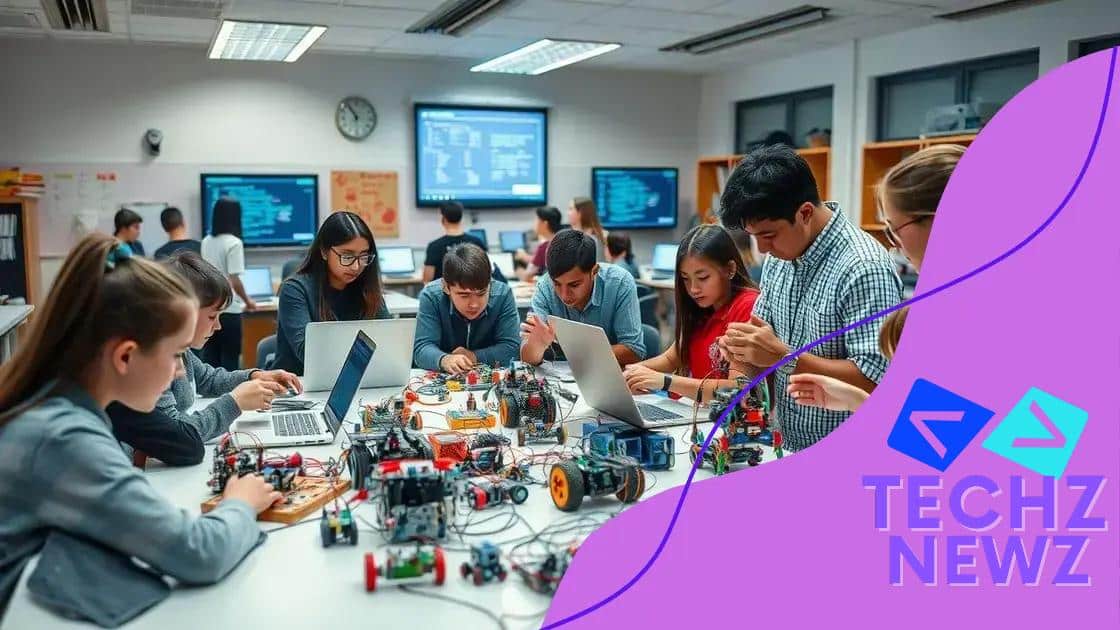Preparing students for future careers in robotics and AI

Preparing students for future careers in robotics and AI involves integrating advanced technologies, emphasizing interdisciplinary learning, and providing diverse opportunities that develop essential technical and soft skills.
Preparing students for future careers in robotics and AI is no longer just an option; it’s a necessity. In today’s tech-driven world, equipping students with the right skills can shape their future and lead them to exciting opportunities. But how exactly can we prepare them?
The importance of robotics and AI in education
In today’s rapidly changing world, the importance of robotics and AI in education cannot be overstated. With technology advancing at a breakneck pace, preparing students for the future requires innovative learning methods. Schools are increasingly recognizing that incorporating these subjects into their curricula is essential for fostering critical skills.
Why Robotics and AI Matter
Robotics and AI are not just buzzwords; they represent the future of many industries. Integrating these fields into education helps students develop vital skills.
- Critical thinking: Students design and troubleshoot robots, enhancing their problem-solving abilities.
- Collaboration: Working on robotics projects fosters teamwork and communication skills.
- Creativity: Building robots allows students to express their unique ideas and innovations.
- Technical skills: Students gain hands-on experience with coding and engineering concepts.
While these skills are crucial, the benefits of robotics and AI in education extend beyond technical knowledge. Students also learn to adapt to new technologies, making them more resilient in a constantly evolving job market.
How Robotics and AI Enhance Learning
Robotics and AI make learning interactive and engaging. For instance, students can program robots to complete specific tasks, which helps solidify their understanding of algorithms and coding. This practical approach encourages exploration and creativity.
Moreover, using AI tools in the classroom can provide personalized learning experiences. By analyzing data on student performance, AI can help teachers identify areas where students need more support. This targeted assistance ensures that all learners can succeed.
As we embrace the importance of robotics and AI in education, we prepare students not just for jobs in technology but for a future where technology is integrated into all aspects of life. Schools play a critical role in this journey, guiding students as they navigate new challenges.
Essential skills for students in robotics and AI
To thrive in the dynamic fields of robotics and AI, students must develop a diverse set of essential skills. Each skill enhances their ability to engage with technology and solve complex problems.
Key Skills for Robotics
Students need to understand the fundamentals of robotics. This includes concepts like mechanics, electronics, and programming. Learning how these elements interact is crucial for any aspiring robotics engineer.
- Problem-solving: Students must learn to identify issues and think critically about solutions.
- Programming languages: Familiarity with languages like Python and C++ is essential for coding robots.
- Hands-on experience: Building and programming robots provides practical skills that are vital in the field.
- Teamwork: Collaborating on projects teaches students the value of working effectively with others.
In addition to technical knowledge, students should also cultivate soft skills. These skills help them to communicate ideas clearly and adapt to various situations.
Skills Related to Artificial Intelligence
When it comes to artificial intelligence, students need to harness a different set of skills. Understanding algorithms and data analysis is fundamental.
- Data literacy: The ability to analyze and interpret data is crucial for AI development.
- Machine learning basics: Knowing how machine learning works helps students create AI systems.
- Ethical considerations: Awareness of the ethical implications of AI ensures more responsible use of technology.
Both robotics and AI require a blend of creativity and analytical thinking. This combination allows students to innovate and push boundaries in technology. As they develop their skills, they lay the groundwork for future careers that will shape the world.
How schools are integrating robotics and AI programs

As technology evolves, schools recognize the importance of integrating robotics and AI programs into their curricula. These programs provide students with valuable skills and prepare them for future careers in innovative fields. By incorporating these subjects, schools inspire a new generation of thinkers and creators.
Curriculum Development
Many schools are developing comprehensive curricula focused on robotics and AI. This approach includes hands-on projects that engage students in meaningful learning experiences.
- Project-based learning: Students work on real-world problems, applying their knowledge to create solutions.
- Interdisciplinary courses: Integrating robotics with subjects like math and science enhances understanding and relevance.
- After-school programs: Many schools offer clubs and extracurricular activities to further explore these technologies.
These intensive programs help students develop essential skills while fostering teamwork and collaboration. By working in groups, students learn to communicate ideas and support one another in their tasks.
Community and Industry Partnerships
Schools are also building partnerships with local businesses and technology organizations. These collaborations provide resources and expertise to enhance educational offerings.
- Workshops and seminars: Guest speakers from the industry share their experiences and knowledge with students.
- Internship opportunities: Students gain hands-on experience in real-world settings, applying their skills in professional environments.
- Equipment donations: Local companies often donate robots and technology tools to schools, enriching the learning experience.
Through these partnerships, students not only learn about robotics and AI but also understand their practical applications. As schools continue to embrace innovation, they prepare students to succeed in an increasingly technological landscape.
Career paths in robotics and AI for students
Exploring career paths in robotics and AI for students opens up exciting opportunities for young learners. As technology continues to advance, the demand for skilled workers in these fields is growing rapidly. Students can prepare themselves for various roles that will shape the future.
Types of Careers Available
Different career paths exist within the realms of robotics and AI. Understanding these options helps students to focus on their interests and aspirations.
- Robotics Engineer: These professionals design, build, and test robots for various applications.
- AI Research Scientist: They develop algorithms and models to improve machine learning and artificial intelligence systems.
- Software Developer: This role involves creating software that drives robots and AI technologies.
- Data Scientist: They analyze data to derive insights that can help in AI decision-making.
Each of these careers requires a unique blend of technical skills and creativity, making them suited for different types of students. Whether one is interested in hands-on building or algorithms, there is a path available.
Education and Skills Needed
To succeed in these careers, students should focus on a solid educational foundation. Relevant subjects include mathematics, computer science, and engineering. Participating in robotics clubs or AI competitions further enhances their skills.
Furthermore, students should cultivate soft skills, such as communication and teamwork, which are vital in collaborative projects. The ability to work well with others will set them apart in their future careers.
As students embark on their journey into the world of robotics and AI, they will find a wealth of opportunities that can lead to fulfilling and innovative careers in technology.
Future trends in robotics and AI education
Understanding the future trends in robotics and AI education is essential for preparing students for upcoming opportunities. As technology advances, education must evolve to meet new demands. Schools are embracing innovative methods to teach these subjects, ensuring students stay engaged and informed.
Incorporating Advanced Technologies
Education technology is playing a vital role in transforming how students learn about robotics and AI. Schools are starting to introduce tools that enhance interactive learning experiences.
- Virtual and augmented reality: These technologies provide immersive experiences, allowing students to explore concepts in a hands-on way.
- Online courses and resources: With the growth of the internet, students can access a wealth of information and courses on robotics and AI.
- AI-driven personalized learning: Adaptive software helps tailor educational content to meet each student’s unique pace and style.
These advancements make learning more engaging and effective, preparing students for real-world applications of their knowledge.
Focus on Interdisciplinary Learning
Future education will also emphasize interdisciplinary approaches. By combining subjects, students can see the connections between robotics, AI, and other fields.
This blending of subjects encourages critical thinking as students solve complex problems. For instance, integrating robotics with art can lead to creative projects that inspire innovative solutions. Furthermore, collaborating across disciplines helps students develop teamwork skills essential for their future careers.
As educational trends evolve, the aim is to make learning relevant and applicable to real-life scenarios. This prepares students not only for jobs in technology but fosters a broader understanding of how these technologies impact society.
Conclusion
As we look towards the future of education in robotics and AI, it is clear that these fields are essential for preparing students for the rapidly evolving job market. By integrating advanced technologies and emphasizing interdisciplinary approaches, schools are equipping students with critical skills. The importance of fostering creativity, teamwork, and technical knowledge cannot be understated. As educators continue to innovate, students will find themselves ready to embrace the challenges and opportunities these technologies present.
FAQ – Frequently Asked Questions About Robotics and AI Education
What are the main benefits of robotics and AI in education?
Robotics and AI encourage hands-on learning, foster critical thinking, and enhance teamwork skills among students.
How can schools integrate robotics and AI programs?
Schools can incorporate robotics and AI by developing relevant curricula, providing hands-on projects, and collaborating with industry partners.
What career opportunities exist in robotics and AI?
There are various career paths, including robotics engineer, AI researcher, software developer, and data scientist.
Why is interdisciplinary learning important in robotics and AI education?
Interdisciplinary learning helps students connect concepts across subjects, making education more relevant and preparing them for real-world applications.





